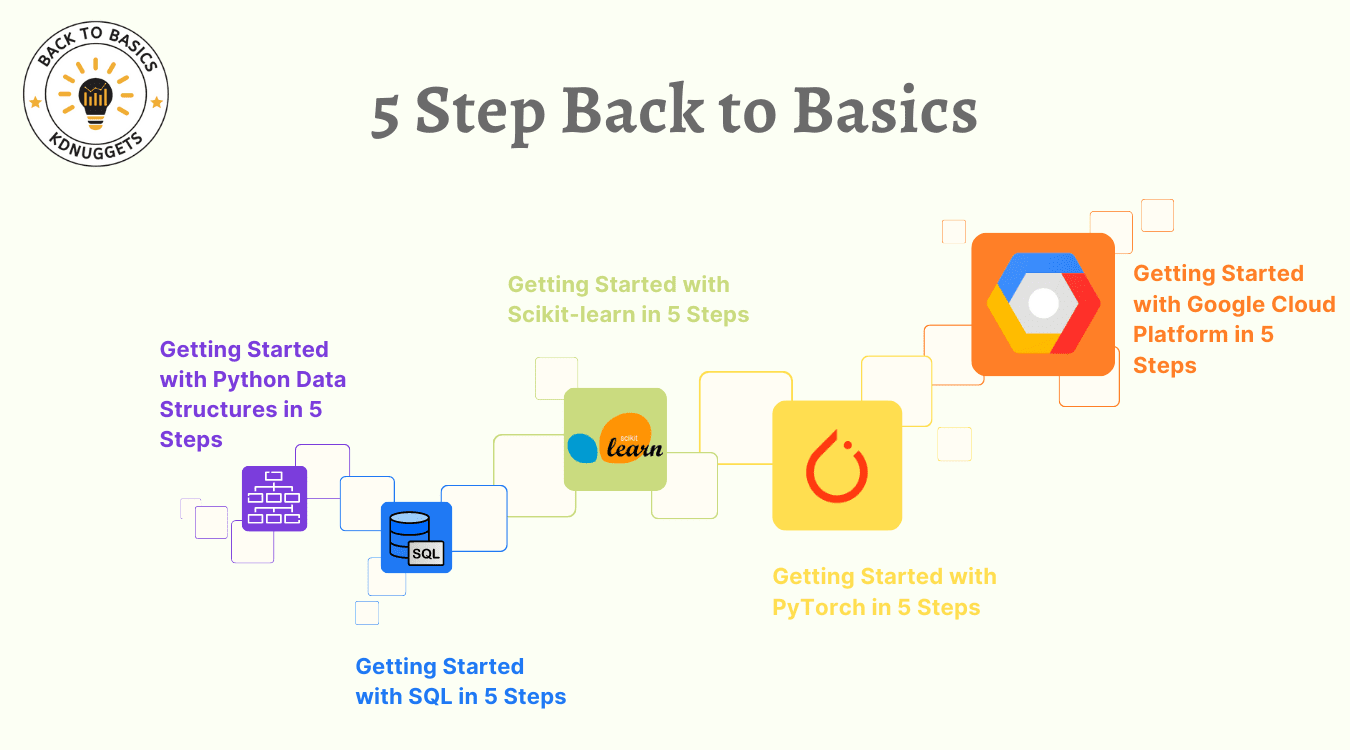
New to the world of data science and machine learning? Welcome to your ultimate guide and starting point, whether you’re looking to break into the industry, learn something new or sharpen your current skills. The Back to Basics: Getting Started in 5 Steps series is all you need and is designed to turn complex concepts into simple straightforward knowledge.
As part of KDnuggets 30 year journey within the data science, machine learning and artificial intelligence space, the team have come together to curate a variety of articles for you to soak up all the knowledge you can.
When starting something new, it’s always hard to get started. The KDnuggets team are taking that weight off your shoulder with our Back to Basics: Getting Started in 5 Steps series, which includes:
- Python Data Structures
- SQL
- Scikit-learn
- PyTorch
- Google Cloud Platform
So let’s get right into it…
This tutorial covers Python’s foundational data structures – lists, tuples, dictionaries, and sets. Learn their characteristics, use cases, and practical examples, all in 5 steps.
When it comes to learning how to program, regardless of the particular programming language you use for this task, you find that there are a few major topics of your newly chosen discipline to which most of what you are being exposed could be categorized.
A few of these, in general order of grokking, are syntax (the vocabulary of the language); commands (putting the vocabulary together into useful ways); flow control (how we guide the order of command execution); algorithms (the steps we take to solve specific problems… how did this become such a confounding word?); and, finally, data structures (the virtual storage depots that we use for data manipulation during the execution of algorithms (which are, again… a series of steps).
Learn the 5 steps: Getting Started with Python Data Structures in 5 Steps
This comprehensive SQL tutorial covers everything from setting up your SQL environment to mastering advanced concepts like joins and subqueries, and optimizing query performance. With step-by-step examples, this guide is perfect for beginners looking to enhance their data management skills.
When it comes to managing and manipulating data in relational databases, Structured Query Language (SQL) is the biggest name in the game. SQL is a major domain-specific language which serves as the cornerstone for database management and provides a standardized way to interact with databases.
With data being the driving force behind decision-making and innovation, SQL remains an essential technology demanding top-level attention from data analysts, developers, and data scientists.
Learn the 5 steps: Getting Started with SQL in 5 Steps
This tutorial offers a comprehensive hands-on walkthrough of machine learning with Scikit-learn. Readers will learn key concepts and techniques including data preprocessing, model training and evaluation, hyperparameter tuning, and compiling ensemble models for enhanced performance.
When learning about how to use Scikit-learn, we must obviously have an existing understanding of the underlying concepts of machine learning, as Scikit-learn is nothing more than a practical tool for implementing machine learning principles and related tasks. Machine learning is a subset of artificial intelligence that enables computers to learn and improve from experience without being explicitly programmed. The algorithms use training data to make predictions or decisions by uncovering patterns and insights.
Learn the 5 steps: Getting Started with Scikit-learn in 5 Steps
This tutorial provides an in-depth introduction to machine learning using PyTorch and its high-level wrapper, PyTorch Lightning. The article covers essential steps from installation to advanced topics, offering a hands-on approach to building and training neural networks, and emphasizing the benefits of using Lightning.
PyTorch is a popular open-source machine learning framework based on Python and optimized for GPU-accelerated computing. Originally developed by Meta AI in 2016 and now part of the Linux Foundation, PyTorch has quickly become one of the most widely used frameworks for deep learning research and applications.
Unlike some other frameworks like TensorFlow, PyTorch uses dynamic computation graphs which allow for greater flexibility and debugging capabilities.
Learn the 5 steps: Getting Started with PyTorch in 5 Steps
Explore the essentials of Google Cloud Platform for data science and ML, from account setup to model deployment, with hands-on project examples.
This article aims to provide a step-by-step overview of getting started with Google Cloud Platform (GCP) for data science and machine learning. We’ll give an overview of GCP and its key capabilities for analytics, walk through account setup, explore essential services like BigQuery and Cloud Storage, build a sample data project, and use GCP for machine learning.
Whether you’re new to GCP or looking for a quick refresher, read on to learn the basics and hit the ground running with Google Cloud.
Learn the 5 steps: Getting Started with Google Cloud Platform in 5 Steps
This Back to Basics: Getting Started in 5 Steps series will have enlightened you on the foundational tools used in data science. You will have familiarised yourself with the basics of Python, SQL, machine learning with Scikit-learn and PyTorch, but also ventured into the Google Cloud Platform.
The path to data mastery does not end here, it is an ongoing journey which requires you to continuously learn new skills and the tools acquired to be proficient.
Keep an eye on KDnuggets for more insights, advanced guides, and the support of a community that’s just as passionate about data science as you are.
Nisha Arya is a Data Scientist and Freelance Technical Writer. She is particularly interested in providing Data Science career advice or tutorials and theory based knowledge around Data Science. She also wishes to explore the different ways Artificial Intelligence is/can benefit the longevity of human life. A keen learner, seeking to broaden her tech knowledge and writing skills, whilst helping guide others.

